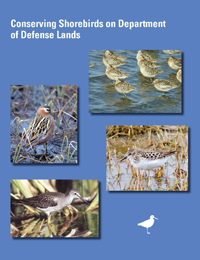Shorebirds are some of the most highly migratory animals known, including ones that routinely travel between the most northern and southern lands of the earth. Although the name suggests all are birds of shorelines, in North America the term is more narrowly applied to roughly 50 kinds of sandpipers, plovers and their allies, some of which live in upland habitats.
To complete their amazing migrations, many kinds of shorebirds make nonstop flights spanning a thousand or more miles without stopping for food or water. To complete these ‘marathons’, they visit migration stopover areas, typically wetlands of one kind or another, where they feed intensively to add large amounts of fat crucial for the ensuing long-distance flight. Unfortunately, more than half of the wetlands that once existed in the United States are now gone, and in some regions strategic to shorebirds more than 90 percent of the wetlands are now gone. Well-focused management initiatives can help provide wetland and other habitats needed by shorebirds and other biota. Along with other large land managers in the U.S., Department of Defense biologists a unique opportunity to manage wetland and upland habitat in ways to benefit wildlife populations, and so help to reverse the rapid population declines we are witnessing.
Today increasing numbers of wildlife managers use management practices to provide suitable wetland and other habitats to migratory shorebirds. To help point out opportunities, WHSRN provides shorebird management training workshops to professional managers. The Shorebird Management Manual, by Douglas L. Helmers, provides a variety of management recommendations, and has assisted managers across the country with ideas for developing specific plans for their sites. The present booklet serves as a companion to the Manual by showing when management initiatives can be timed for targeted species or guilds of shorebirds.
Each of the 50 species of shorebirds common in North America has its own unique life history, including migration ‘style.’ Preferred habitats vary with species, as do migration routes and schedules. For managers seeking to focus on a particular type of wetland and/or a particular species of shorebird, it is essential to know when management opportunities can be scheduled to properly coincide with targeted bird migration schedules. This booklet will assist DoD resource managers in identifying important shorebird management opportunities by providing (1) information on migration timing of various ‘habitat guilds,’ and (2) information on the relative abundance of different species of shorebirds in different regions of the country during spring and autumn migrations.

